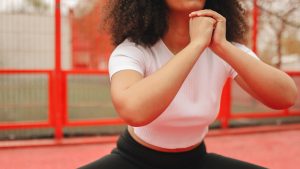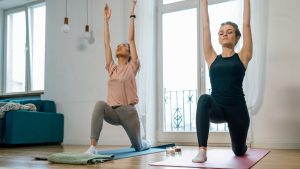Enhancing Hip Flexibility in Yoga: Essential Squat Poses
1. Malasana (Garland Pose)
Malasana deeply stretches the hips, groins, and lower back while engaging the core.
To perform Malasana:
Begin in a standing position, feet slightly wider than hip-width apart.

Lower your hips down, coming into a squat position.
Bring your palms together at your heart center, using your elbows to press your knees gently apart.
Keep your spine long and breathe deeply, staying in the pose for several breaths.
2. Anjaneyasana (Low Lunge)
Anjaneyasana targets the hip flexors, promoting flexibility and release.
Steps for Anjaneyasana:
Start in a high lunge position with your right foot forward.

Lower your left knee to the mat and untuck your toes, keeping the right knee directly above the ankle.
Sink your hips forward and down, feeling a deep stretch in the left hip flexor.
Raise your arms overhead or place your hands on your front thigh, maintaining a steady breath.
Additional Tips:
Consistency: Practice these poses regularly to see improvements in hip flexibility.
Mindful Breathing: Focus on deep, steady breaths to relax into the stretches.
Modifications: Use props like blocks or blankets to support your body if needed.
Warm-up: Prioritize a gentle warm-up before engaging in deep hip-opening poses.
By integrating these squat-based yoga poses into your routine, you can effectively enhance hip flexibility, paving the way for a more balanced and invigorating yoga practice.
Practice with patience and mindfulness, allowing these poses to guide you on your journey towards improved hip flexibility in your yoga practice.
The Importance of Hip Flexibility in Yoga
Hip flexibility is a cornerstone of a well-rounded yoga practice. The hips, being a complex joint, play a pivotal role in various yoga poses, affecting stability, balance, and overall body alignment.
Why Focus on Hip Flexibility?
Enhanced Range of Motion: Flexible hips allow for a broader range of motion in yoga asanas, enabling deeper stretches and more fluid movements.
Improved Posture: Tight hips can lead to poor posture. Opening up the hip area helps align the spine and promotes better posture both on and off the mat.
Injury Prevention: Flexible hips can reduce the risk of injuries, particularly in the lower back and knees, by distributing the stress of movement more evenly across the body.
Energetic Release: In yogic philosophy, the hips are considered a storage point for emotional tension. By releasing tension in this area, practitioners often experience emotional release and a sense of freedom.
Further Poses to Enhance Hip Flexibility:
4. Utkatasana (Chair Pose)
Utkatasana engages the hips and thighs, stimulating flexibility while strengthening the lower body.
Steps for Utkatasana:
Stand with your feet together.
Inhale, raise your arms overhead, palms facing each other.
Exhale, bend your knees and lower your hips as if sitting in an imaginary chair.
Keep your weight in your heels and lengthen your spine. Hold for a few breaths.
5. Eka Pada Rajakapotasana (Pigeon Pose)
Pigeon pose deeply stretches the hip flexors and glutes, aiding in hip flexibility.
Practice Pigeon Pose:
Start in a tabletop position. Bring your right knee toward your right wrist and extend your left leg behind you.
Lower your hips toward the mat, keeping the front leg externally rotated.
Fold forward over your front leg, maintaining a neutral spine. Switch sides.
Importance of Alignment and Safety
While enhancing hip flexibility is crucial, it’s equally vital to prioritize proper alignment and safety in yoga practice. Avoid forcing your body into deep stretches; instead, listen to your body and progress gradually.
External Links for Deeper Understanding:
Yoga International – Exploring Hip Openers
Mindbodygreen – Unlock Your Hips
YogaOutlet – Hip-Opening Poses Guide
For further exploration on hip flexibility and yoga, here are some external resources you might find helpful:
Yoga Journal – Hip-Opening Yoga Poses
DOYOUYOGA – 10 Hip Opening Yoga Poses
The Yoga Sequence – Hip Flexibility Exercises
By incorporating these poses and maintaining a mindful approach to your practice, you’ll witness gradual improvements in hip flexibility, fostering a deeper connection between mind, body, and breath in your yoga journey.
Comparison tabular
Here’s a tabular comparison summarizing the key aspects of each pose:
| Pose | Focus | Steps | Benefits |
|---|---|---|---|
| Malasana (Garland Pose) | Hips, groins, lower back | 1. Stand with feet wider than hip-width apart. 2. Lower into a squat. 3. Palms together at heart center, elbows pressing knees gently apart. | – Stretches hips, groins, lower back. – Engages core muscles. |
| Anjaneyasana (Low Lunge) | Hip flexors, deep stretch | 1. Start in a high lunge with right foot forward. 2. Lower left knee to mat, untuck toes. 3. Sink hips forward, keeping front knee over ankle. 4. Raise arms or place on thigh. | – Targets hip flexors for flexibility. – Helps release tension. |
| Baddha Konasana (Bound Angle) | Hips, groin, relaxation | 1. Sit with feet together, knees out. 2. Hold feet or ankles. 3. Fold forward from hips, keeping spine straight. | – Opens hips and groin. – Encourages relaxation. |
| Utkatasana (Chair Pose) | Hips, thighs, lower body strength | 1. Stand with feet together, arms overhead. 2. Lower into a seated position. 3. Maintain weight in heels. | – Engages hips and thighs. – Strengthens lower body. |
| Eka Pada Rajakapotasana (Pigeon) | Hip flexors, glutes, deep stretch | 1. Start in tabletop. 2. Bring right knee toward right wrist. 3. Extend left leg behind. 4. Lower hips and fold forward. | – Stretches hip flexors and glutes deeply. – Aids hip flexibility and release of tension. |
Comparison Insights:
Focus: Each pose targets specific areas such as hips, groin, hip flexors, or lower back.
Steps: Varied steps are involved in transitioning into these poses, emphasizing different body alignments.
Benefits: From stretching to engagement, each pose offers unique benefits, from flexibility enhancement to relaxation and strengthening.
Consider integrating a combination of these poses into your yoga routine to experience a holistic improvement in hip flexibility, strength, and relaxation. Always practice with awareness of your body’s limits and enjoy the journey of exploration within your yoga practice.
Wrapping up
Improving hip flexibility through yoga is a transformative journey that extends beyond physical gains. Integrating these essential squat poses into your practice can cultivate not only flexibility but also mindfulness and self-awareness.
Remember, the essence of yoga lies not only in achieving perfect poses but in the mindful connection between breath, body, and mind. Embrace your individual progress, honoring your body’s capabilities while gently pushing its boundaries.
By consistently practicing these poses with patience and mindfulness, you’ll gradually unlock the potential for increased hip flexibility, leading to a more fulfilling and enriching yoga practice.
So, step onto your mat, breathe deeply, and embark on this empowering journey toward enhanced hip flexibility in yoga. Embrace the process, savor each stretch, and celebrate the beautiful union of movement, breath, and inner harmony that yoga offers.

Hey there, it’s Mike Rrsq, the Editor-in-Chief over at Jsquat.com, and I’m absolutely obsessed with all things squat fitness! I’ve been lucky enough to get some serious recognition for my work in this field. With a solid background in the fitness and wellness industry, I’ve been there right from the get-go, helping shape this website into what it is today.
You see, I’m not just the boss around here; I’m also a passionate contributor. I love sharing my insights through my articles, and trust me, they’re not your run-of-the-mill stuff. Each piece I write is a labor of love, filled with my expertise and real-world experience in the fitness universe. So, if you’re into fitness and looking for some inspiration, you’re in the right place!
Related Posts
- The top 4 effective squat Variations 18-year-old males and females need to improve flexibility in athletes.
Flexibility is a crucial component of athletic performance, and incorporating the right squat variations can…
- Should back squat make me feel a challenge in my hip flexibility
Back squats can indeed challenge your hip flexibility. When you perform a back squat, your…
- The top 4 effective squat Variations 18-year-olds need to improve sprint speed
Improving sprint speed involves various factors, and incorporating specific squat variations into your training routine…
- The top 3 effective squat Variations 28-year-olds need to improve their vertical leap
When it comes to enhancing your vertical leap, squats are a foundational exercise. They work…
- How can Ballet Squat (Plie Squat) help improve balance
The ballet squat, also known as a plié squat, is a fantastic exercise for enhancing…
- Best 3 most effective squat variations you need for targeting the adductor magnus.
Squat is one of the most effective exercises that you can do to target quads…
- The Best 3 Most Effective Squat variations for targeting the obliques.
Squats are renowned for their ability to strengthen and tone the lower body, but did…
- The best 5 most effective squat variations you need for better basketball performance
Basketball demands a unique blend of strength, agility, and explosive power. Choosing the right squat…
